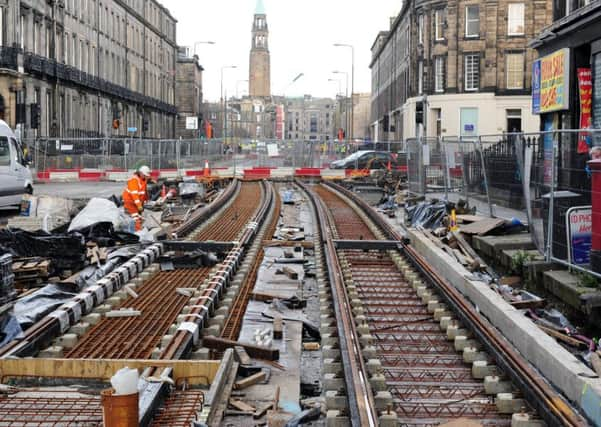Edinburgh Tram Inquiry: How did Edinburgh's trams become a fiasco?


The Capital’s tramline – up and running since 2014 – was scaled back to save money, but still damaged many businesses and has been blamed for some having to close.
Former Lord Advocate Lord Hardie was appointed three years ago to look into what went wrong with the project, which ended up costing £776 million – or £1 billion if you add the interest payments on the borrowed money.
Advertisement
Hide AdAdvertisement
Hide AdHe and his team have reviewed more than six million documents, as well as taking statements from a wide range of people involved in the project.
And tomorrow the long-awaited public hearings will begin, offering the first insights from key players on what was going on behind the scenes as the costs mounted and the delays lengthened. Among the issues the inquiry is expected to focus on are whether the original contract drawn up to deliver the trams was flawed, whether councillors were kept properly informed about the project as it progressed and the troubled relations between the council, its arms-length company TIE and the contractors.
The Scottish Government announced £375 million funding in March 2003 to pay for two tram routes in the Capital totalling 15 miles – one from Edinburgh Airport to Newhaven costed at £165m and the other from Haymarket to Granton via Crewe Toll costed at £190m. It was said the first trams could be running by 2009.
But the cost quickly started rising – it was £473m by the end of 2003 and £714m by September 2005 after it emerged initial estimates failed to take inflation into account.
Advertisement
Hide AdAdvertisement
Hide AdThe whole project came under threat in 2007 after the SNP came to power and moved to scrap the trams.
The opposition parties combined to save the scheme and Finance Secretary John Swinney pledged the agreed government funding of £500m would go ahead – but “not a penny more”.
The government also pulled Transport Scotland out of any involvement with the project, arguably losing its ability to monitor how the work was progressing and how its money was being spent.
Major roads including Princes Street and Leith Walk were dug up, turning the heart of Edinburgh into a building site, deterring people from coming to the city centre and damaging local businesses.
Advertisement
Hide AdAdvertisement
Hide AdDespite that upheaval, it was decided in April 2009 that the section of the route between the city centre and Newhaven had to be scrapped as costs continued to escalate.
Meanwhile, a bitter dispute between TIE and the main contractor Bilfinger Berger brought work to a halt for months. Numerous personnel quit the project, one of them David Mackay, branding it “hell on wheels”.
The council organised mediation talks and brokered a resolution of the dispute between TIE and Bilfinger to get the project back on track.
The first witness tomorrow will be Jenny Dawe, who was Lib Dem council leader 2007 –2012. She will be followed by Lesley Hinds, who was Labour transport convener leading up to the opening of the line in May 2014.
Advertisement
Hide AdAdvertisement
Hide AdTory transport spokesman Councillor Nick Cook said: “Taxpayers will not soon forget the catastrophic issues which plagued the initial tram project, or the ballooning bill that followed.
“It is vital that the Hardie Inquiry gets the most out of those finally sitting down to get evidence and delivers conclusions that are substantive and robust.”
Transport convener Councillor Lesley Macinnes said: “We welcome the tram inquiry and hope that any recommendations will benefit public bodies, especially local authorities, when it comes to the commissioning and carrying out of major infrastructure projects.”
Key questions the probe must answer
How much was the flexible tram contract to blame for the escalating disputes and costs? And could that have been reasonably foreseen?
Advertisement
Hide AdAdvertisement
Hide AdWas there sufficient scrutiny by the politicians who were ultimately in charge?
Did the council and its arms-length transport firm TIE have the necessary skills and experience?
Were the council and TIE open and honest about the problems that developed, or did they try to cover them up?
How much did the government’s hands-off approach contribute to the problems?
Rising costs and bitter disputes
Advertisement
Hide AdAdvertisement
Hide AdMAR 2003: Scottish Government announces £375m funding for trams.
DEC 2003: Cost of two tramlines estimated at £473m, leaving £98m shortfall.
JAN 2004: Legislation introduced at Holyrood to build two tramlines.
SEPT 2005: Cost reaches £714m after it emerges inflation was not included.
Advertisement
Hide AdAdvertisement
Hide AdMAY 2007: Work gets under way in Leith with project completion date of 2011.
JUNE 2007: Project survives SNP attempt in Scottish Parliament to scrap it.
FEB 2009: Dispute flares between TIE and contractors.
APR 2009: City-centre to Leith part of route is scrapped.
MAR 2011: Mediation talks brokered by council.
MAY 2014: First trams start running on Capital’s streets.